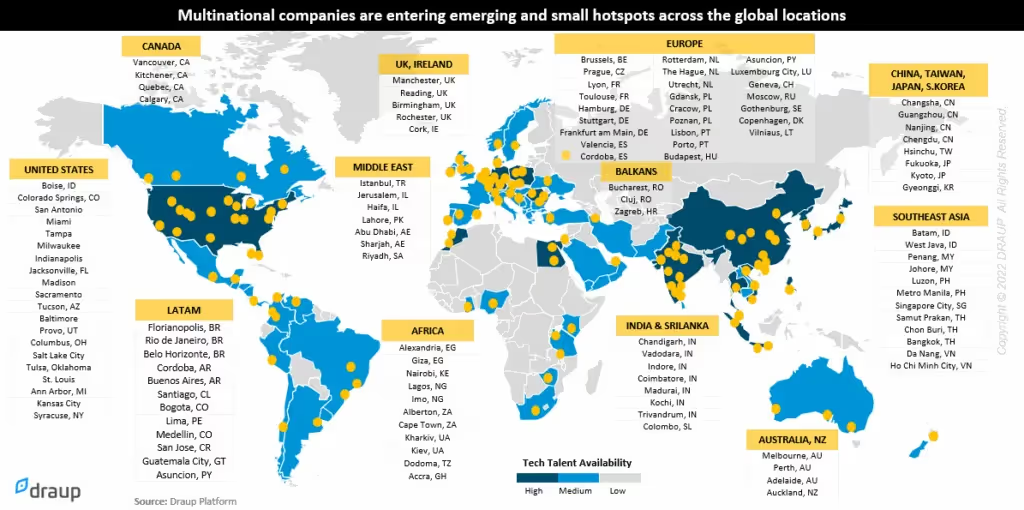Recruiting Challenges & Trends Across Emerging Talent Hotspots
This week we studied two exciting case studies and how contrasting the approaches were.
Case Study 1: Based in Tokyo, Takata corporation started as a manufacturer of seat belts, child seats, and seat covers for Automobiles. Takata ruled this space. As its mission was passenger safety, its natural progression was to expand to Airbags. In the late 1990s, Takata started sourcing its airbag inflators from a third party. Unfortunately, an untraceable flaw led to numerous fatalities. Having no internal expertise on a critical component led to the decline of Takata. Takata did not institutionalize the ability to experiment, test, and scale internally.
Case Study 2: Even when Sundar Pichai was still an Engineer at Google, he was convinced that Google should have its Browser. Eric Schmidt, the then-CEO of Google, was absolutely against it. Sundar Pichai rallied a few engineers to build the Chrome browser and demonstrated its power to Eric Schmidt and the rest, as they say, is history.
Case Study 1, where risk was avoided entirely, and the company collapsed, and Case Study 2, where risk-taking is celebrated, the company thrived.
Risk-taking culture is essential for Location evaluation parameters. Here are some factors attributed to Silicon Valley and why it is super successful. (This was summarized in a dissertation thesis at the Eastern Institute of Technology – New Zealand)
Several critical elements of what can be considered to be the Silicon Valley model include:
- Ease of market entry: There are low barriers to entry for early startups (Klarin et al., 2021).
- Tertiary institute connections and the presence of research institutes: The presence of university connections and the possibility of working with research institutes to help develop the business (Fung et al., 2016).
- Risk culture: A culture that accepts business failure and rewards risk-taking.
- Venture capital firms and angel investors: The presence of multiple financing options, including angel investors, venture capitalists, and specialist venture law firms.
- Draup also believes in University Spinouts (Ideas started at University but successfully transitioned into a company). It is an important metric. Genentech is born this way. This attribute requires a fundamental shift to not focus on publishing but focus on creating
- Global search and talent attraction capability and, within this context, a diverse workforce (Cukier & Kon, 2018)
(In other words, availability of talented recruiters)
This framework provides a different set of parameters for location analysis, and the recency of the studies is also exciting
Here are some interesting labor market trends this week:
- Equifax expands its Global Business Service Operations in Costa Rica. Equifax will focus more on Cybersecurity operations through this expansion
- Low Code/No Code centers of excellence are getting launched in India and Romania at a higher rate
- Radware opens a new cybersecurity center in Milan- Italy
- SiliconLabs opens its global center for engineering and wireless connectivity innovation in Hyderabad
- Five startups in the Chicago area raised over 360 million USD in September alone (Atlas, which enables companies to pay their overseas employees, based in Chicago, is a company to watch for)
- There are debates on why Poland, a great tech ecosystem, has only one Unicorn from the region. Indeed, there are about 10 to 15 companies in the pipeline of unicorn candidates
- Norway continues to establish its position on becoming a leader in Industrial VR
- Latin America continues to push boundaries on Digital Transformation. Mexico and Argentina climbed positions in the global Digital competitiveness survey
- The upcoming World AI summit shows a lot of buzz about Cognitive Cities (the next version of smart cities)
The cognitive city is built on three pillars:
- The ability for citizens and enterprises to connect digitally to physical things,
- Ability to compute or analyze those things and contextualize,
- Using that connectivity to drive new decisions. (prediction)
- (the use case given is, For example, a residential refrigerator can be equipped with intelligent sensors to monitor when food supplies fall below a specified threshold and a new order is needed. A fully digitalized operation can supply products and arrange delivery to the resident’s door by a robot
- NEOM in Saudi Arabia aspires to be this city
- Still in the nascent stages, but we will monitor the summit output and report
Many Global HR leaders in our network communicate a few essential things that complicate hiring in this new age:
- Roles and companies are heavily examined by the candidates on their match with their personal goals and values.
- Disruption to working patterns has seen increased demand for flexibility, so contract, freelance, and remote roles are in demand.
- A recruiter should act like a Recruitment Scientist, constantly calibrating the current trends with the Candidate’s needs
- A recruiter should also say that, at times, the job is not a match for the Candidate (even if skills match)
- A recruiter should be well aware of local and global ecosystems
Several cities are emerging/developing in the global talent scene due to new investments or MNC companies prioritizing expansion. Here is an initial list compiled by Draup. It will be refined further into a report we plan to release by the end of the year.

Overall, we are pretty excited about HR’s role under emerging circumstances. If we plan the initiatives correctly, we can accelerate transformation and adaptation and make the enterprises genuinely care for a great workplace.










.svg)




















.svg)





.svg)
